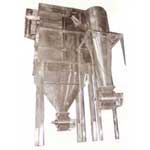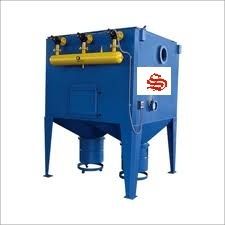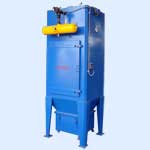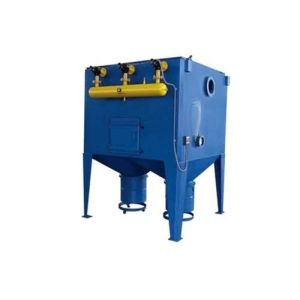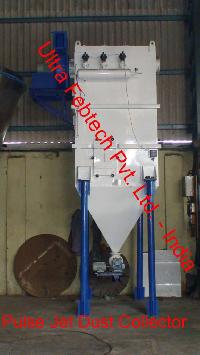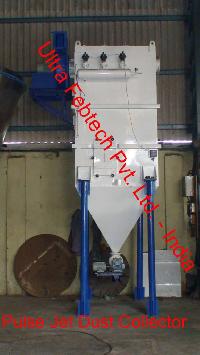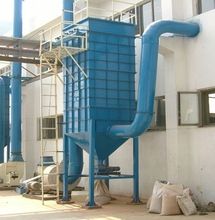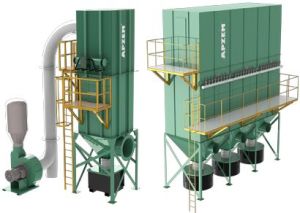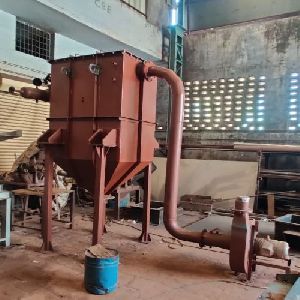Listing ID #1788421
Company Information
Ask for more detail from the seller
Contact SupplierBoth shaker collectors and fabric pulse jet collectors had limited dust collection efficiency when it came to applications such as high density dust from powder coating booths. The high-density dust from these powder-coating booths caused the fabric pulse jet collectors to operate at a high pressure drop and thereby increased compressed air requirements for cleaning. Another problem was that exhaust air could not be recycled into work areas due to high amount of dust penetration into adjacent bags. Cartridge dust collectors overcame the above problems effectively.
The Cartridge collector uses a perforated metal cartridge with a cellulose filter pleated, non woven filter media, bound by steel caps at the top and bottom. The end caps were joined with the cellulose media and outer and inner cores by an adhesive. Cellulose media was used because it has pressure drop qualities similar to those of felted media in pulse jet collectors. Pleated media filter elements with narrow pleat spacing (8 pleats per inch) are efficient for filter cakes (formed with fine dusts) that are less than 0.02 inch thickness. Narrow pleat spacing loses its relevance when dust particle size is beyond 0.03 inch. The pleated design provides greater amount of filtering area while occupying lesser space. Consequently the air - filter media ratio, pressure drop and collector size reduce considerably.
Cartridge dust collectors are highly efficient in collection of dust with high bulk densities and fine dust particles. Filter cake forms well at low pressure drop but it had high filtration efficiency. In a study conducted it was found that the outlet dust flow in cartridge collectors was the least in comparison with other dust collectors in foundry operations as shown below:
| Collector type | Outlet dust flow |
| Pulse jet fabric collector | 0.0660 grains/cu.ft |
| Shaker collector | 0.00035 grains/cu.ft |
| Cartridge collector | 0.00005 grains/cu.ft |
Cyclic Pulse Cleaning Increases Cartridge Efficiencies
Thicker dust cakes on filter elements that were cylindrical were found to be efficient and reduced the requirement of compressed air. An efficient solution to clean coarse dusts was by introducing a cleaning ‘cycle’ (as opposed to continuous cleaning) that activated on pressure setting. A pressure switch such as a photohelic gage was used for this application and pressure switch setting was at 3 ½ inches water gage. By operating the collector at a pressure of ¼ inch water column above the initial pressure drop, the pressure actuated cleaning system is best utilized. By shortening off time cleaning interval, the pressure drop can be stabilized. The frequency of the cycles can be reduced if greater amount of dust can be removed in each cycle. The lower pulsing frequency in cylindrical cartridges implies that dust penetration to adjacent filter media is reduced since dust penetration is directly related to pulsing frequency.
Though pleated filter elements can also operate with a pressure switch actuation system, we must understand that the pressure drop setting in these elements is normally limited by pleat spacing. The dust loading could be minimal in applications such as fume dusts and welding operations that may require only one or two cleaning cycles per day. Further compressed air utilization increases with narrow pleat spacing.
Eg. Considering the initial pressure drop across a pleated filter media to be 0.1 inches water gage, we can see that if ‘bridging’ (filling up) of pleat groove with dust occurs, then cleaning air flow is obstructed in the portion below the dust bridge. In such a case cleaning air has no option but to take the path of least resistance that makes all the media below the bridge ineffective. In such cases pressure switches can be set for dusts that can filter effectively at a wide range of pressure settings.
Assuming a dust load of 2 grains per cubic foot and pressure switch settings are provided at 1 ½, 2 ½ or 3 ½ inches water column, we get the following results:
| Pressure Switch |
Cleaning Cycle Time |
Compressed air usage at 85 psig |
|---|---|---|
| 1 ½ inch w.c. | 5 minutes | 0.7 scfm per 1000 acfm filtered air |
| 2 inch w.c. | 5 minutes | 0.6 scfm per 1000 acfm filtered air |
| 2 ½ inch w.c. | 4 minutes | 0.9 scfm per 1000 acfm filtered air |
| 3 ½ inch w.c. | 3 minutes | 1.2 scfm per 1000 acfm filtered air |
Cleaning Action in Cartridge Collectors
Cleaning action is achieved by compressed air jet. The jet enters the top of the filter element and expands at an angle of 14-16 degrees, drawing clean air from the clean air plenum. When this expanding air flow enters the filter element, it loses its capability to draw more clean air because the filter and the dust cake offer resistance to the flow. The air jet starts compressing the clean air in the filter element causing a pressure wave that expels the fan air present in the filter element. Once fan air is expelled, a positive pressure is created which sweeps out accumulated dust that has collected on the outside surface of the filter media in the dirty air chamber.
In pleated design, dust is displaced at the speed of cleaning air jet in a perpendicular path from the filter media surface. This prevents dust from striking the adjacent media, which is also ejecting dust at an angle. This advantage is lost in cylindrical and envelope bag pulse collectors where dust is thrown on to the adjacent rows during cleaning action. Pleated cartridge filter design has one of the better collection efficiencies due to this factor of not propelling dust to the adjacent bags.



